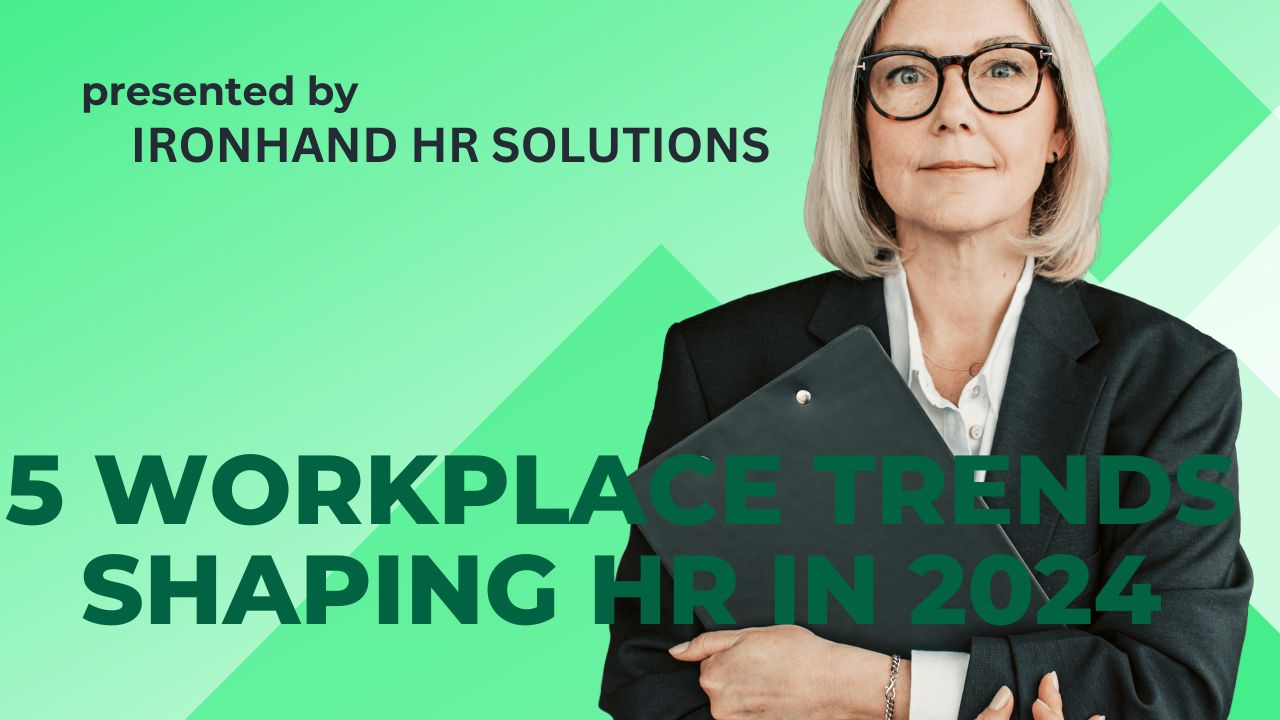Intro: Why 2024 Is a Defining Year for HR
As we move into 2024, technology rapidly advances. Employee priorities are shifting. Additionally, changes in the global economy continue to reshape HR. HR leaders handle hybrid workforce. They must also navigate the ethics of AI in recruitment. HR leaders face the challenge of staying agile and proactive. Recognizing these five key trends can help HR teams strategically position their organizations. They can attract and keep top talent. It also helps enhance workforce potential and stay resilient against emerging challenges.
1. AI and Automation in HR
- Trend Overview: Artificial intelligence (AI) and automation tools are quickly transforming traditional HR functions. Beyond automating routine tasks, AI now enables more personalized employee experiences. This is achieved through customized learning paths. Additionally, predictive analytics find potential flight risks among high-performing employees. AI’s role in recruitment, onboarding, performance management, and engagement continues to expand. Tools like chatbots, automated interview scheduling, and sentiment analysis are becoming commonplace.
- Real-World Example: Many companies, like Unilever, have adopted AI-driven recruitment tools. These tools screen resumes and conduct early assessments. They even analyze video interviews to detect potential hires’ enthusiasm and engagement. This shift has not only sped up the hiring process but also significantly reduced recruitment costs.
- Challenges: While AI offers efficiencies, it also introduces risks, especially in areas like data privacy and algorithmic bias. Without careful oversight, AI-based decisions in hiring or performance evaluation may inadvertently perpetuate bias or compromise sensitive employee data.
- Actionable Insights: HR leaders should focus on transparency and ethics when implementing AI. Create clear guidelines on how AI tools will be used. Make sure a human review process remains part of critical decision-making. Regularly audit AI tools for biases and encourage continuous feedback from employees to improve AI interactions in HR.

2. The Rise of Hybrid Work 2.0
- Trend Overview: The first rush to hybrid work highlighted the importance of flexibility. Yet, organizations are now evolving their hybrid models to be more structured and inclusive. Companies are exploring new ways to balance remote work with in-office presence, creating policies that encourage collaboration without sacrificing productivity. “Hybrid Work 2.0” is more intentional, with companies investing in tools and spaces that support both remote and on-site employees seamlessly.
- Case Study: Microsoft has taken strides with its hybrid work model, focusing on flexibility while ensuring collaboration. The company introduced “Team Together Days” for in-person teamwork and virtual collaboration tools to support employees working across time zones. This balance has helped foster a unified company culture while respecting individual work preferences.
- Challenges: Managing a hybrid workforce poses challenges. These include communication gaps and decreased visibility of remote employees’ work. There is also a risk of potential isolation and disengagement. Ensuring fairness in performance evaluations across on-site and remote workers remains a significant hurdle.
- Solutions: Establishing hybrid-friendly policies, like flexible hours and structured meeting days, can enhance cohesion. Invest in digital tools that promote asynchronous collaboration, allowing remote employees to contribute on their schedules. Train managers in remote leadership skills, emphasizing inclusion, communication, and regular check-ins to ensure everyone stays engaged.
3. Mental Health and Employee Well-being as Business Priorities
- Trend Overview: Mental health is now a core part of HR strategies. Companies recognize its direct impact on productivity. They see its influence on retention and overall company morale. Organizations are increasingly offering mental health resources. They implement flexible work policies. Companies offer supportive environments. The goal is to create a workplace culture that values well-being as much as performance.
- Statistics: A recent survey by the American Psychological Association shows important information. It indicates that 87% of employees expect their employers to support mental health. In response, companies have ramped up mental health benefits, with 68% of organizations planning to increase well-being programs by 2024. Research has shown that these investments can lead to a 21% improvement in productivity and a 41% decrease in absenteeism.
- Challenges: One challenge for organizations is balancing well-being investments with costs, especially for smaller companies. Additionally, addressing the stigma around mental health is crucial. It encourages employees to use the resources provided without fear of judgment.
- Insights: Practical initiatives can significantly boost employee morale. These include flexible work hours, access to mental health counseling, and on-site relaxation spaces. Regularly survey employees to gauge well-being needs and adapt programs based on feedback. Normalizing conversations about mental health in the workplace can also reduce stigma and encourage employees to seek help when needed.
4. Upskilling and Reskilling to Combat Skills Gaps
- Trend Overview: As industries rapidly evolve, skills gaps have become a major concern. Upskilling and reskilling efforts are crucial for companies aiming to stay competitive. In 2024, there will be an even greater focus on developing in-house talent. Upskilling programs not only tackle technical and digital skills but also include soft skills like adaptability, critical thinking, and leadership.
- Real-World Example: Amazon has invested billions in its “Upskilling 2025” initiative. This program aims to train employees in high-demand fields like cloud computing and machine learning. This approach allows the company to fill specialized roles internally, reducing the reliance on external hiring.
- Challenges: Identifying the right skills to develop is challenging. Measuring the return on investment (ROI) for training initiatives is difficult. Additionally, employees may hesitate to join if they fear it could add to their workload without tangible rewards.
- Actionable Solutions: HR should collaborate with leadership to find key skill gaps tied to business goals. Create structured learning paths with defined milestones, incentives, and opportunities for real-world application. Additionally, emphasize the benefits of these programs for career advancement to motivate employees to join actively.
5. DEI (Diversity, Equity, Inclusion) Beyond Lip Service
- Trend Overview: Diversity, Equity, and Inclusion (DEI) initiatives are moving beyond rhetoric and into actionable, data-driven frameworks. Companies are implementing measurable goals, tracking DEI metrics, and holding leaders accountable. From recruitment to promotions and retention, DEI is becoming a core part of organizational strategy. This change reflects a genuine commitment to equity and representation.
- Example: Salesforce has been a pioneer in DEI. The company has set ambitious representation goals. It transparently shares its progress with employees and the public. The company’s “Equality and Inclusion” initiative includes training to reduce bias in hiring. It also offers mentorship programs for underrepresented groups. Additionally, it regularly releases data on diversity metrics.
- Challenges: Securing genuine buy-in from leadership is a key obstacle. Addressing unconscious biases that persist in hiring and promotion processes is another significant challenge. It’s also essential to make certain that DEI efforts don’t become tokenistic or reduced to superficial gestures.
- Key Takeaways: HR can implement practical steps to strengthen DEI. For example, they can anonymize resumes to reduce bias. They can use diverse hiring panels. Additionally, creating safe spaces for open conversations on diversity issues is beneficial. Regularly measure and report DEI progress to build trust and accountability. By embedding DEI values into everyday practices, companies can foster a more inclusive, productive, and innovative culture.

Conclusion: Staying Ahead in HR’s Dynamic Future
As we move further into 2024, these trends highlight the dynamic nature of HR’s role in the workplace. HR leaders can help their organizations attract top talent by embracing AI thoughtfully. They achieve this by evolving hybrid work models, prioritizing mental health, closing skills gaps, and committing to authentic DEI. This engagement is crucial in a rapidly changing world. The future belongs to those who adapt. HR’s ability to proactively shape these trends is crucial for defining organizational success.

